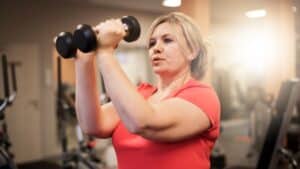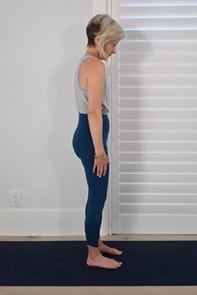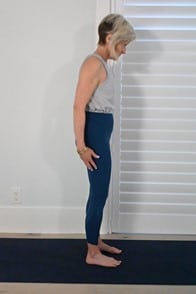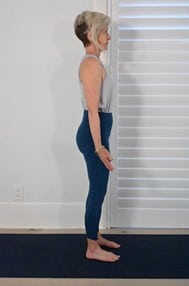
I often get asked about posture and osteoporosis exercises when we’re past menopause. Here are my answers to many burning questions.
What Is the Difference Between Posture and Alignment?
I prefer to use the term alignment because the word posture implies to me an aesthetic choice whereas I am focused on optimal functionality! You can use either word.
What Do You Mean by Optimal Alignment?
Your body is designed to have the path of weight from gravity fall through your head, evenly through your shoulders and spine, to your hips and then heels.
The heels are big and broad and strong for a reason. They were designed for impact and ground reaction force. Simply put, the muscle and bone targeting forces of “weight-bearing” exercise are activated by the ground reaction force of gravity.
Logically, if your hips are forward of your ankles, your weight is more in your toes, not great for your foot, but also the path of weight is now falling more through your knees than your backside. Hello, knee problems and weak gluteus muscles.
Not only do our glutes and hamstrings play an important role in hip bone building but they are key for sitting and getting out of a chair, a very important movement that we do not want to lose as we age.
Another less talked about area is the ribcage. We want the ribcage to be sitting above the hips and not tipped or tilted forward. Such a position makes it difficult to engage one’s core, and it also puts pressure on your low back. There is so much more to be said, but this is a good overview.
How Important Is It to Keep Your Shoulder Blades Together and Down Your Back So Your Shoulders Are Back?
This is a very common question. And I would like to dispel the myth that pulling your shoulder blades down and back will actually improve your posture. What it may in fact do is just add more tension to an already sub optimal spinal alignment. The easiest way I can show this is with a photograph.



As you can see in the first photograph, I have a kyphotic posture, or an upper spine that rounds forward. I can alter this by merely pulling my shoulder blades back and looking more upright (second photo). But in fact, I haven’t changed that forward posture.
Pulling the shoulder blades back via the rhomboid muscles when I’m standing doesn’t actually make my spine more elongated. Yet, I will suggest that you use your rhomboids in exercises.
The third photograph is standing more erect without so much forward shoulder and head. My shoulders are NOT pulled back, they are sitting easily. I have externally rotated my arms to find a bit more openness in my chest.
Here are some hints to follow:
1. Work on your shoulder blade mobility by doing rhomboid push-ups. The goal is to decrease the kyphotic curve. Getting more active movement in protraction and retraction will be a big help.
2. Elongate your spine. Sometimes we talk about reaching the crown of your head more towards the ceiling. But we want to do that without extreme extension in the neck.
3. Work on getting your hips back first, before worrying about your shoulder blades. You want to have a more stacked alignment from your heels to your hips. And then get to work on the stacked alignment in your upper body.
4. You should be looking at doing more thoracic extension. It’s a slow process and the changes are small, maybe 1% at a time. Good exercises for encouraging more thoracic extension include baby cobra, gentle rotations from side to side, and cactus arms at the wall facing away from the wall. (You will work on getting your arms on the wall completely while also keeping the back of your ribs on the wall.)
What’s the Principle Behind Hip Hinge?
The principle behind the hip hinge is to keep your spine in neutral. This means that the natural curves of your spine are kept intact. A hinge is where you keep that neutral arrangement and move your torso, including your pelvis, over your legs.
A great tool here is a broomstick or a dowel. The 3 important points on the dowel are the head, the rib cage and the sacrum or the back of the pelvis. For some people, a forward head posture makes it difficult to get their head on the stick.
Try to keep the relationship of your head exactly the same vis a vis the stick. Keep your ribs and your sacrum on the stick. By doing so, you are protecting your lumbar spine and your thoracic spine. The biggest issue is unhinging or raising back up.
What you really need to have is a good core strategy. So even if your hamstrings are very flexible, you should only hinge over as far as you have the strength to bring yourself back up without changing your spine.
For people who don’t have a good core connection yet, start very small and progress to bigger hinges over time. A hip hinge, when done properly, is a great exercise to strengthen the entire back chain of your body.
Is It Better to Focus on Pilates and Yoga or Weights at the Gym?
This question requires breaking down.
How Often Should You Strength Train?
We all should strength train. I acknowledge up front that this does not mean heavy lifting and may need 1-pound weights for some individuals. We know that 2 to 3 days a week with a heavy for you weight is optimal for hypertrophy or building muscle.
How Often Should You Do More Endurance Based Exercises?
This type of work can be aerobic for heart health, or it can be longer, slower core work such as Pilates or yoga. Many people suggest 2 or 3 times a week for this kind of exercise for either your heart or your mobility and balance, or both.
I recently heard some scientific literature explained on a podcast that suggests a plan like this:
- Strength train 3 times a week, endurance train 2 times a week, and rest two days a week. You would do that for 10 weeks.
- Next, you start a new cycle where you endurance train for 3 days a week, strength train for 2, and rest for 2 during that cycle.
Of course, you may choose one day of rest with a more restorative practice on day 6.
The most important thing is to listen to your own body. You should be able to determine your own level of fatigue. If you try strength training three days a week, do you still feel energetic on the 6th day?
I have clients who start out strength training with such light weights for safety reasons, that they really need three days a week. But other clients really push themselves and 2 days a week is optimal. These people may choose to not alter their training schedule every 10 weeks because they know what works for them.
As we age, we know our repair functions work more slowly than when we were younger, so we must be vigilant about listening to our own body and its signals. We must prioritize rest!
Why Should We Wear Minimalist Shoes?
I always stress the importance of wearing minimalist shoes. I’ve written an extensive article on my reasons why, and another on over 30 minimalist shoes suggestions.
What Is the Protocol for Weighted Vests?
A weighted vest is not appropriate for everyone. In the end, it is your personal decision, and I am not a medical professional. When my clients ask me, I tell them it would be an informed decision if they know their bone quality as well as their bone density.
Additionally, you want to take your spinal conditions into account. If you have severe scoliosis or spondylothesis, or any number of other disc or spine deformities or degenerations, you must take these into account. It may be that you will choose to walk with a weighted belt and only add load to your hips and not your spine in the interest of safety.
Should you decide to use a vest, the protocol is to progressively load slowly. One would start with a half-pound, and if the first walk with a half-pound was successful, then one would load another half-pound each time one took a walk. As you get to a heavier load (the point that something is “heavy” is very individual), you would be wise to take more time to adjust to the load before increasing your weight.
It may well be that you would walk for a week with five pounds, for instance, and the following week, see if five and a half pounds is okay. So, your progression would slow down. The suggested maximum in the medical community is 10% of your body weight.
Have You Found a Vest That Places the Weight Near the Center of Gravity?
The assumption here is that a person has their center of gravity somewhere in front of the sacrum when standing. So, if you were looking to carry most of your weight in that spot, you would want to be able to wear a weighted belt that sits a little lower than your natural waist.
But I do think another good option is the hyper vest elite. It is made so that you can put two weights in any one pocket to redistribute the weight and get more of it near that theoretical center of gravity. From that perspective, I think the Ironwear Fitness Vest is not as good because it’s a much shorter vest. If you’re taller than 5’7”, the Ironwear Fitness Vest may be too short for you.
What Are Good Yoga Poses for Upright Posture?
Tree, Chair, triangle if done with a neutral spine, Warrior I, II, III with a neutral spine.
When I Deadlift, My Knees Crack. Is That Okay?
Consistent cracking is an indication of a hydrogen pop, a tendon moving over a bone, or two things rubbing together. I am not fond of letting that happen consistently over time as it seems like there would be a wear and tear event at some point.
However, I recently listened to a lecture where this notion was dispelled when it involves your Iliopsoas complex because that is a big strong muscle set that is unlikely to be eroded in this way.
Nonetheless, you might want to experiment with a lower weight and see if the knees still crack. Additionally, I would also suggest taking a slow motion video of yourself while performing the deadlift. You may discover that you are either hyperextending your knees or maybe they are drifting inwards or outwards.
Disclaimer: This article is not intended to provide medical advice. Please consult with your doctor to get specific medical advice for your situation.
Do you think your body is well aligned? Do you do any exercises to correct your posture? What questions do you have regarding exercising for osteoporosis?





